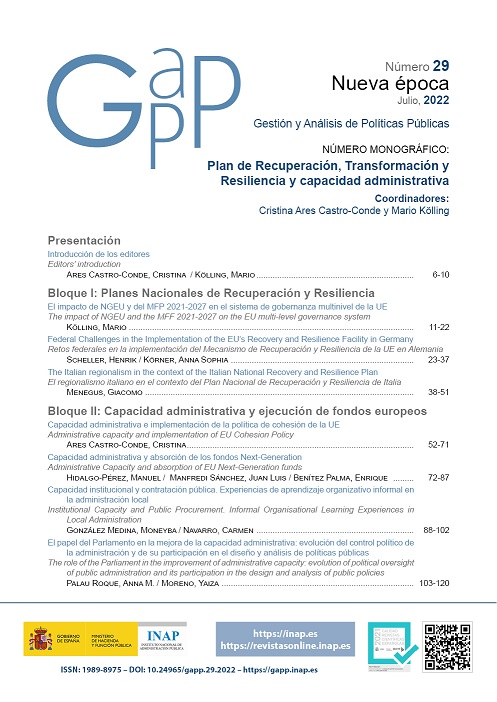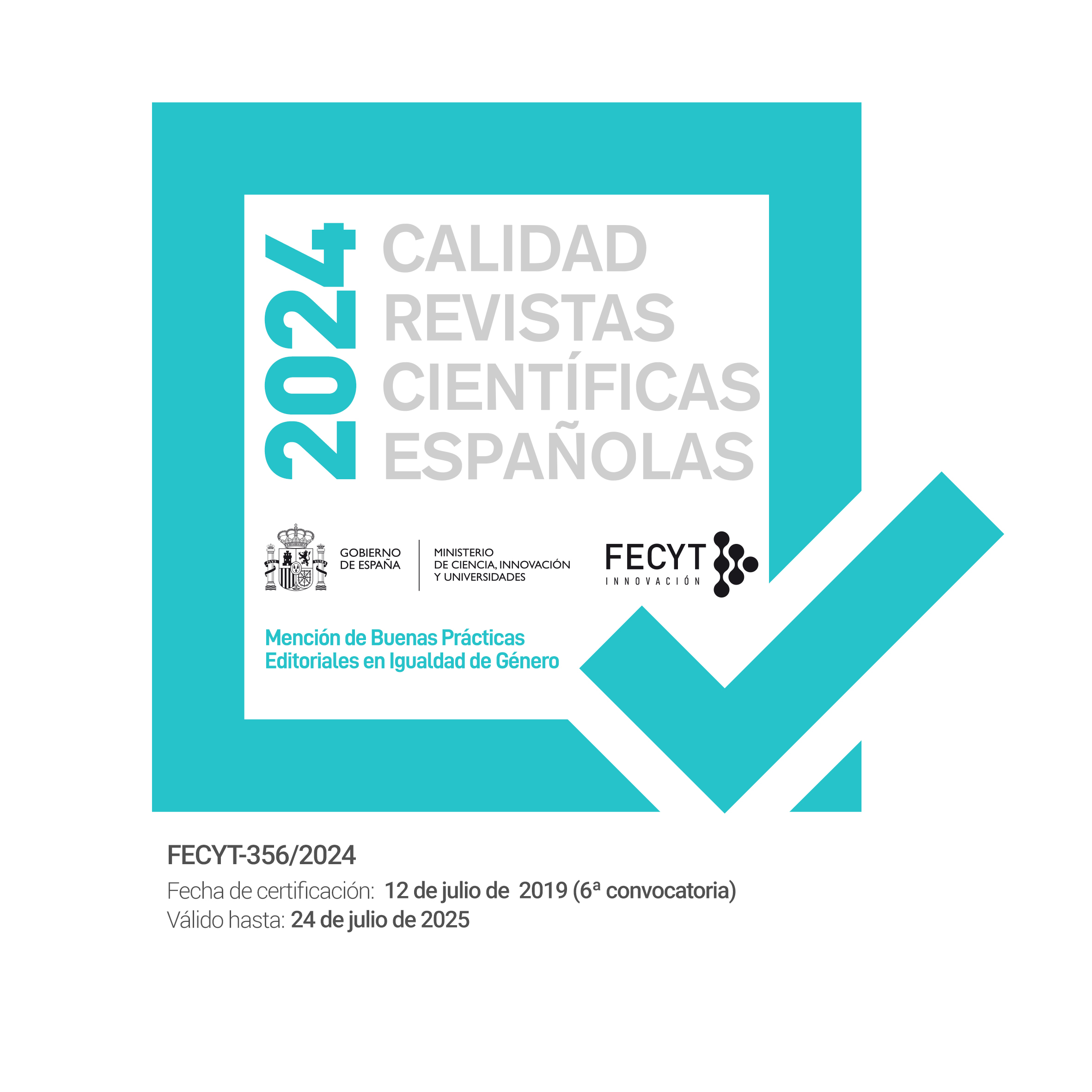Administrative capacity and implementation of EU Cohesion Policy
DOI:
https://doi.org/10.24965/gapp.11061Keywords:
Administrative capacity, EU cohesion policy, Directorate-General for Regional and Urban Policy (DG REGIO), policy capacityAbstract
The success of EU cohesion policy, as it happens more generally with the public policies that are made at the EU level, is dependent on the administrative capacity of the public organizations with implementing powers within each Member State, including the regional and local tiers. The necessity to develop these skills in different territories and sectors, to guarantee the execution of the investments assigned, has required the European Commission, in cooperation with the OECD in some initiatives, to provide diverse tools for national Administrations to help them to strengthen these skills. This contribution reviews the conceptual literature on policy capacity, and it clarifies the definition of administrative capacity. Furthermore, it examines various empirical papers that deal with the link between administrative capacity and the absorption of EU funds, along with the main projects for administrative capacity development that have been conducted by the European Commission’s Directorate-General for Regional and Urban Policy (DG REGIO).
Downloads
References
Acemoglu, D. y Robinson, J. A. (2019). El pasillo estrecho: Estados, sociedades y cómo alcanzar la libertad. Deusto.
Arias Moreira, X. C. (coord.) (2021). La calidad de las instituciones y la economía española. Papeles de Economía Española, 168 (Número monográfico). https://www.funcas.es/revista/la-calidad-de-las-instituciones-y-la-economia-espanola/
Banco Mundial (2020). Worldwide Governance Indicators. http://info.worldbank.org/governance/wgi/
Bertelsmann Stiftung (2018). Policy performance and governance capacities in the OECD and EU: Sustainable Governance Indicators 2018. https://www.bertelsmann-stiftung.de/en/publications/publication/did/policy-performance-and-governance-capacities-in-the-oecd-and-eu-2018/
Berwick, E. y Christia, F. (2018). State Capacity Redux: Integrating Classical and Experimental Contributions to an Enduring Debate. Annual Review of Political Science, 21, 71-91. https://doi.org/10.1146/annurev-polisci-072215-012907
Capano, G. (2020). Policy design and state capacity in the COVID-19 emergency in Italy: if you are not prepared for the (un)expected, you can be only what you already are. Policy and Society, 39(3), 326-344. https://doi.org/10.1080/14494035.2020.1783790
Capano, G. y Lippi, A. (2022). States’ performance, reforms and policy capacity in Southern European countries. En L. Burroni, E. Pavolini y M. Regini (eds.), Mediterranean Capitalism Revisited: One Model, Different Trajectories. University Press Scholarship Online.
Charron, N., Dijkstra, L. y Lapuente, V. (2015). Mapping the regional divide in Europe: A measure for assessing quality of government in 206 European regions. Social Indicators Research, 122, 315-346. https://doi.org/10.1007/s11205-014-0702-y
Charron, N., Lapuente, V. y Rothstein, B. (2013). Quality of Government and Corruption from a European Perspective. A Comparative Study of Good Government in EU Regions. Edward Elgar Publishing. https://doi.org/10.4337/9780857936943
Cingolani, L. (2013). The State of State Capacity: a review of concepts, evidence and measures (MERIT Working Papers 2013-053). United Nations University-Maastricht Economic and Social Research Institute on Innovation and Technology (MERIT).
Comisión Europea (2016). Arachne. Be distinctive. https://doi.org/10.2767/790939
Comisión Europea (2017). Marco de competencias de la UE para la gestión y ejecución del FEDER y el Fondo de Cohesión. https://ec.europa.eu/regional_policy/sources/policy/how/improving-investment/competency/userguide_and_annex2_es.pdf
Comisión Europea (2018a). Guía práctica de contratación pública para profesionales sobre cómo evitar los errores más comunes en los proyectos financiados con cargo a los Fondos Estructurales y de Inversión Europeos. https://doi.org/10.2776/12906
Comisión Europea (2018b). A comparative overview of public administration characteristics and performance in the EU28. Oficina de Publicaciones de la UE. https://doi.org/10.2767/13319
Comisión Europea (2020a). Good Governance for Cohesion Policy: Administrative capacity building. https://doi.org/10.2776/940335
Comisión Europea (2020b). Refuerzo de la buena gobernanza y de la capacidad administrativa para la política de cohesión; acción piloto en cooperación con la OCDE. https://ec.europa.eu/regional_policy/es/information/publications/factsheets/2020/strengthening-of-good-governance-and-administrative-capacity-for-cohesion-policy-pilot-action-in-cooperation-with-the-oecd
Comisión Europea (2020c). Hojas de ruta para el refuerzo de la capacidad administrativa. Conjunto práctico de herramientas. https://ec.europa.eu/regional_policy/es/information/publications/guides/2020/roadmaps-for-administrative-capacity-building-practical-toolkit
Dimitrova, A. (2002). Enlargement, Institution-Building and the EU’s Administrative Capacity Requirement. West European Politics, 25(4), 171-190. https://doi.org/10.1080/713601647
El-Taliawi, O. G. y Van Der Wal, Z. (2019). Developing administrative capacity: an agenda for research and practice. Policy Design and Practice, 2(3), 243-257. https://doi.org/10.1080/25741292.2019.1595916
Farazmand, A. (2009). Building Administrative Capacity for the Age of Rapid Globalization: A Modest Prescription for the Twenty-First Century. Public Administration Review, 69(6), 1007-1020. http://www.jstor.org/stable/40469017
Fukuyama, F. (2016). Los orígenes del orden político: desde la prehistoria hasta la Revolución francesa. Deusto.
Honadle, W. B. (1981). A Capacity-Building Framework: A Search for Concept and Purpose. Public Administration Review, 41(5), 575-580. https://doi.org/10.2307/976270
Incaltarau, C., Pascariu, G. C. y Surubaru, N.-C. (2020). Evaluating the Determinants of EU Funds Absorption across Old and New Member States – the Role of Administrative Capacity and Political Governance. Journal of Common Market Studies, 58(4), 941-961. https://doi.org/10.1111/jcms.12995
Milio, S. (2007). Can Administrative Capacity Explain Differences in Regional Performances? Evidence from Structural Funds Implementation in Southern Italy. Regional Studies, 41(4), 429-442. https://doi.org/10.1080/00343400601120213
Organización para la Cooperación y el Desarrollo Económicos (OCDE) (2020). Strengthening Governance of EU Funds under Cohesion Policy Administrative Capacity Building Roadmaps. OECD Publishing. https://doi.org/10.1787/9b71c8d8-en
Parsons, W. (2004). Not just steering but weaving: Relevant knowledge and the craft of building policy capacity and coherence. Australian Journal of Public Administration, 63(1), 43-57. https://doi.org/10.1111/j.1467-8500.2004.00358.x
Peters, B. G. (2015). Policy capacity in public administration. Policy and Society, 34(3-4), 219-228. https://doi.org/10.1016/j.polsoc.2015.09.005
Polidano, Ch. (2000). Measuring Public Sector Capacity. World Development, 28(5), 805-822. https://doi.org/10.1016/S0305-750X(99)00158-8
Rodríguez-Pose, A. y Ketterer, T. (2020). Institutional change and the development of lagging regions in Europe. Regional Studies, 54(7), 974-986. https://doi.org/10.1080/00343404.2019.1608356
Shubham, S., Shi, L. y Wu, X. (2021). The Policy Capacity of Bureacracy. Oxford Research Encyclopedias, Politics. https://doi.org/10.1093/acrefore/9780190228637.013.1399
Smeriglio, A., Bachtler, J., De Francesco, F., Olejniczak, K., Thomson, R. y Śliwowski, P. (2015). Administrative capacity-building and EU cohesion policy. Paper 1: Literature Review. European Policies Research Centre (EPRC), School of Governance and Public Policy, University of Strathclyde. https://institute.eib.org/wp-content/uploads/2016/10/wp1-litreview.pdf
Thomas, V. (2006). Linking individual, organizational, and institutional capacity building to results. Capacity Developments Briefs, 19. http://hdl.handle.net/10986/9585
Treib, O. (2014). Implementing and complying with EU governance outputs. Living Review in European Governance, 9(1). https://doi.org/10.12942/lreg-2014-1
Van der Wal, Z. (2017). The 21st Century Public Manager: Challenges, People and Strategies. Palgrave.
Verheijen, T. (2007). Administrative Capacity in the New EU Member States. The Limits of Innovation? World Bank Working Paper, 115. https://doi.org/10.1596/978-0-8213-7155-8
Vidal, G. y Barragué, B. (2020). La capacidad del sector público en España: el sistema sociosanitario durante la COVID-19. En A. Penadés de la Cruz y A. Garmendia (dirs.), Informe sobre la democracia en España 2020: el año de la pandemia (pp. 78-91). Fundación Alternativas.
Wu, X., Ramesh, M. y Howlett, M. (2015). Policy capacity: A conceptual framework for understanding policy competences and capabilities. Policy and Society, 34(3-4), 165-171. https://doi.org/10.1016/j.polsoc.2015.09.001
Downloads
Published
How to Cite
Issue
Section
License
Copyright (c) 2022 Gestión y Análisis de Políticas Públicas

This work is licensed under a Creative Commons Attribution-NonCommercial 4.0 International License.












